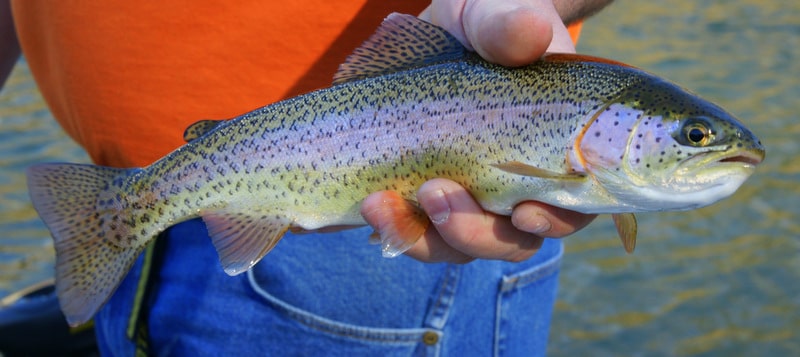Trout:
What is it?, History, cultivation, nutritional value, uses, recipes, and more...
Rainbow trout (Oncorhynchus mykiss) is a fish belonging to the salmonid family. It distinguishes itself from other trout species by the broad pink-purple stripe on each of its sides. It is considered the most widely cultivated species globally due to its resilience and ease of breeding.
Índice
What is the Rainbow Trout?
The rainbow trout is a visually striking fish that exhibits colors varying according to its habitat, age, and reproduction. It has a torpedo-like shape and is typically blue-green or yellow-green with a pink stripe on each side. It features a white belly and displays black spots on its dorsal area and fins.
This species is a relative of the salmon and, like the salmon, can reach a good size. On average, it measures between 51 and 76 centimeters in length and weighs around 3.6 kilograms. However, specimens have been found to reach up to 1.2 meters in length and weigh up to 24 kilograms.
Its streamlined body has 60 to 66 vertebrae, 3 to 4 dorsal spines, 10 to 12 soft dorsal rays, 3-4 anal spines, 8-12 soft anal rays, and 19 caudal rays. An adipose fin is present, usually with a black edge.
Trout residing in flowing waters and those that migrate tend to be darker with more intense coloring, while lake residents are brighter and more silvery.
History of the Rainbow Trout
The rainbow trout is native to rivers and lakes in North America west of the Rocky Mountains. However, it has been introduced worldwide due to its popularity in sport fishing and its exquisite flesh.
The production of this fish expanded primarily in the 1950s with the development of pelleted feed. Trout fishing and cultivation are maintained in highland basins of many tropical and subtropical countries in Asia, East Africa, and South America. With its expansion, various domesticated local lineages or strains have been developed, while others have emerged through selective breeding and constant crossbreeding to improve the quality of fish for cultivation.
The rainbow trout was introduced to Peru in the 1930s, brought from North America; it is now a naturalized species. Nowadays, it is mainly cultured in regions such as Puno, Junín, Pasco, Cuzco, Ancash, Cajamarca, Piura, Amazonas, La Libertad, Huánuco, Lima, Arequipa, Moquegua, Tacna, Abancay, Apurímac, and Huancavelica.

Common Name of the Rainbow Trout
| Spanish | Trucha arco iris, trucha patagónica |
| French | Truite arc-en-ciel |
| English | Rainbow trout |
Scientific Name of the Rainbow Trout
xxxxxxxxxxxx
Taxonomy of the Rainbow Trout
| Kingdom | Animalia |
| Filo | Chordata |
| Class | Actinopterygii |
| Order | Salmoniformes |
| Family | Salmonidae |
| Subfamily | Salmoninae |
| Gender | Oncorhynchus |
| Specie | O. mykiss Walbaum, 1792 |
Synonymy of the Rainbow Trout
Salmo mykiss Walbaum, 1792.
Oncorbyncbus mykiss (Walbaum, 1792).
Parasalmo mykiss (Walbaum, 1792).
Oncbon-bycbus mykiss (Walbaum, 1792).
Salmo purpuratus Pallas, 1814.
Salmo gail-dneri Richardson, 1836.
Paria gairdneri (Richardson, 1836).
Salmo gairdnerii Richardson, 1836.
Salmo gairdner’ii gairdnerii Richardson, 1836.
Salmo gairdneri irideus Gibbons, 1855.
Salmo gairdnerii irideus Gibbons, 1855.
Salmo iridea Gibbons, 1855.
Salmo irideus Gibbons, 1855.
Salmo rivularis Ayres, 1855.
Salmo stellatus (Girard, 1856).
Salmo truncatus Suckley, 1859.
Salmo masoni Suckley, 1860.
Salmo kamloops (Jordan, 1892).
Oncorbyncbus kamloops ]ordan, 1892.
Salmo rivularis kamloops (Jordan, 1892).
Salmo gairdneri sbasta jordan, 1894.
Salmo gilberti ]ordan, 1894.
Oncorbyncbus mykiss nelsoni Evermann, 1908.
Salmo nelsoni Evermann, 1908.
Salmo irideus argentatus B
Etymology of the Rainbow Trout
Rainbow Trout: The word comes from Late Latin “tructa,” which in turn originates from the ancient Greek word τρώκτης (trōktēs), meaning “voracious.”
Oncorhynchus: A term derived from Greek “ogko,” meaning mass or swollen, in conjunction with “rhyngchos,” meaning snout.
Habitat of the Rainbow Trout
- Habitat
Habitat of the Rainbow Trout
The rainbow trout prefers living in cold, clean rivers, streams, and lakes, although some leave freshwater to reach the sea. Migratory specimens usually acquire a silvery tone and spend several years in the ocean before returning to their birthplace river to spawn.
Rainbow trout feed on insects, crustaceans, and small fish. They are resilient and spawn without significant complications; their growth is rapid, and they can tolerate a wide range of environments. While abundant worldwide and lacking a special protection status, they are considered pests in certain regions where they have been introduced.
This species can withstand various temperatures (0-27 °C), but for spawning and growth, they tend to stay between 9-14 °C. The optimal water temperature for cultivating rainbow trout is below 21 °C. With appropriate temperature and food availability, maturity is usually reached at 3-4 years of age.
Females can produce up to 2,000 eggs/kg of body weight. Eggs are relatively large (3-7 mm), and most only spawn once in spring, although selective breeding and photoperiod adjustments have produced hatchery strains that can mature earlier and spawn year-round.
In aquaculture, the inclusion of synthetic pigments like astaxanthin and canthaxanthin in their diet results in the pink coloration often seen in wild specimens that feed on freshwater shrimp (which contain natural carotenoid pigments).
Geographical Distribution of the Rainbow Trout

Amazonas, Áncash, Apurímac, Arequipa, Ayacucho, Cajamarca, Cusco, Huancavelica, Huánuco, Junín, La Libertad, Lima, Pasco, Piura, Puno, Tumbes
Year-round Availability of the Rainbow Trout
- Available throughout the year.
Subspecies of the Rainbow Trout
The following subspecies of this type of trout can be considered:
-
Oncorhynchus mykiss aquilarum
Oncorhynchus mykiss gairdneri (Richardson, 1836) Oncorhynchus mykiss gilberti (Jordan, 1894) Oncorhynchus mykiss irideus (Gibbons, 1955)
-
Oncorhynchus mykiss kamloops
Oncorhynchus mykiss (Walbaum, 1792) Oncorhynchus mykiss nelsoni (Evermann, 1908) Oncorhynchus mykiss stonei (Jordan, 1894) Oncorhynchus mykiss whitei (Evermann, 1906)
Nutritional Value of Rainbow Trout
Trout meat has a low level of fat, contains no carbohydrates or sugar, and provides only 111 calories to a person’s diet. Furthermore, it offers vitamins B9, B3, B12, and B7, as well as vitamin D, vitamin E, folic acid, and vitamin A. It is also an important source of minerals essential for proper bodily function, including phosphorus, selenium, potassium, magnesium, manganese, calcium, zinc, copper, iron, and sodium.
Rainbow trout has a high protein value that aids in strengthening and accelerating muscle growth. Similar to salmon, it is a reliable source of Omega-3 fatty acids.
Thanks to its low salt content, this fish is suitable for individuals with hypertension.
Health Benefits of Rainbow Trout
This is a technical summary in 1 or 2 lines of the preceding text. (Example: High vitamin C content)
Contraindications or Side Effects
Rainbow trout is contraindicated for those who suffer from fish and seafood allergies. On the other hand, it can become contaminated with parasites, so it is recommended to cook it thoroughly before consumption to eliminate potential pathogenic microorganisms.
Moreover, trout may cause discomfort for individuals with liver and gastrointestinal conditions. In cases of abnormal blood triglyceride levels or heart problems, consumption of fried trout and the addition of salt should be avoided.
| 10 Porciones por Kilogramo | |
| Tamaño de porción | 100g |
| Cantidad por porción Calorías |
111 |
| Cantidad por 100g | |
| Energía | 465 kJ |
| Grasa Total | 3.1 g |
| Sodio | 52 mg |
| Carbohidratos totales | ● |
| Carbohidratos disponibles | ● |
| Fibra Dietaria | ● |
| Proteínas | 19.5 g |
| Calcio | 19 mg |
| Fósforo | 245 mg |
| Zinc | 0.66 mg |
| Hierro | 0.22 mg |
| Potasio | 361 mg |
| Agua | 75.8 g |
| Cenizas | 1.2 g |
| Vitamina A | 17 μg |
| Tiamina (B1) | 0.35 mg |
| Riboflavina (B2) | 0.33 mg |
| Niacina (B3) | 4.50 mg |
| Vitamina C | 1.00 mg |
| Acido Fólico (B9) | 0 μg |
| β-Caroteno | 0 μg |
| Fuente: Tablas peruanas de composición de alimentos – Centro Nacional de Alimentación y Nutrición – Ministerio de Salud – Perú | |
Derived Products and Forms of Consumption of Rainbow Trout
Uses of Rainbow Trout
The primary uses of rainbow trout include gastronomy, where it features in a myriad of preparations; medicinal, owing to its diverse nutritional contributions; and industry, where it stands out in cosmetic, food, and aquaculture sectors.
- Culinary
- Medicinal
- Industrial
Culinary Use of Rainbow Trout
Rainbow trout is a fish that lends itself to many cooking methods and has the advantage of easily removable bones. Larger trout are generally preferred for oven preparations, accompanied by garnishes, vegetables, and vinaigrette or garlic-based sauces.
When fried, trout acquires an exquisite flavor that can be enhanced with spices like parsley, chervil, tarragon, dill, basil, bay leaves, among others. Additionally, it can be stuffed with ham or mushrooms to add a distinct taste. Its fillets are easy to digest and chew, making them suitable for individuals with chewing difficulties, reduced appetite, children, and elderly individuals with delicate health.
As a low-calorie food, it is also considered suitable for low-fat diets and weight loss regimens.
Medicinal Use of Rainbow Trout
An aqueous extract of trout cartilage is produced, containing proteoglycan and uronic acid, which is used in the creation of products to prevent and/or treat osteoarthritis.
Furthermore, trout scales are one of the active ingredients in certain pharmaceutical compositions aimed at preventing and treating proliferative cellular diseases.
Industrial Use of Rainbow Trout
Rainbow trout is employed in various industries:
Cosmetic Industry: Creams, tonics, and dressings; antioxidants and anti-aging products have been created from the fatty acids and proteins present in the fish's flesh. Dermatologically, some of these products have been proven to effectively reduce wrinkles and other signs of aging.
Likewise, trout eggs are used to obtain a cellular extract through a thermal process, which, when mixed with other components, is used to manufacture topical cosmetic products like lotions, gels, ointments, sprays, or powders. This formula stimulates the growth of stem cells, increases the concentration of hyaluronic acid, elastin, and anti-inflammatory factors, which help reduce fine lines and wrinkles on the skin.
Food Industry: Hydrolyzed trout meat is used to create a nutritional composition that improves animal growth rates. This food inhibits the growth of pathogenic microorganisms that affect tilapia and trout crops, enhancing fish health and immunity against various conditions. Furthermore, this obtained meal can be implemented in the diet of any animal due to its antimicrobial, antioxidant, and nutritional capabilities.
Aquaculture Industry: Trout farming, known as "truchicultura," is a specialized cultivation of trout and has been practiced for several hundred years. It is the most cultivated fish species in the country due to its demand in the international market, especially in Europe.
In Peru, there are more than 2,800 rainbow trout producers, and in the year 2020 alone, national trout production reached 54,000 tons, as reported by the National Sanitary Authority for Fisheries (Sanipes).



